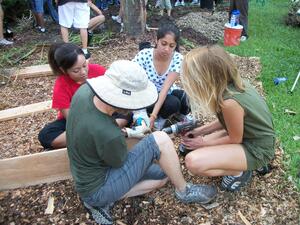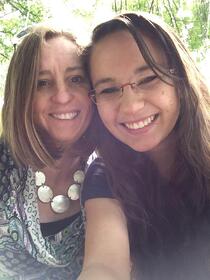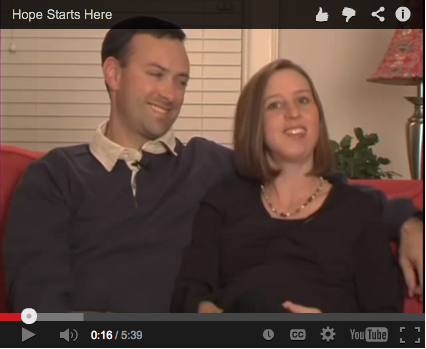Service Learning Curriculum Ideas for Food Drive Projects that will Maximize Impact
 Food drives are intended to educate students about food inequity and encourage students to take action. But is this what is indeed happening in class rooms and campuses? When not properly planned, food drives can do just the opposite, producing unintended consequences that reinforce or exacerbate stereotypes students hold about people living in poverty. Today we are providing ways to use service learning to overcome common challenges of food drives and maximize your intended meaningful impact.
Food drives are intended to educate students about food inequity and encourage students to take action. But is this what is indeed happening in class rooms and campuses? When not properly planned, food drives can do just the opposite, producing unintended consequences that reinforce or exacerbate stereotypes students hold about people living in poverty. Today we are providing ways to use service learning to overcome common challenges of food drives and maximize your intended meaningful impact.
THE BIG PICTURE
Let us take one step back. To avoid negative outcomes, we need to first understand when there is an imbalance of education and action, food drives can unintentionally be piloted in the wrong direction. A private high school in San Francisco used to take students to the poorer parts of town to volunteer at soup kitchens and food banks for a few hours at a time. Malcolm Singer, the school director of community service-learning, explains what can happen when there is action without proper education, “What we realized, when we were driving them back to school, was that (students) were saying the same things about hunger and poverty that they had been saying the day before. We realized we were reinforcing the same negative stereotypes.”[1] The same problem often occurs with food drives-- as there is typically little or no interaction between students and the community their donations are intended to help, and food drives may include little education about the root causes of hunger and poverty. The way to create a food drive that positively impacts both students and the community is simple – educate students about the issues of social justice and show them how to take action. Once a student becomes aware of the injustices in the world, they aspire to be a part of the improvement.
EDUCATE
Nearly fifty million Americans face food insecurity.[2] Education should be centered on the root causes of hunger and poverty with curriculum focusing on who, what, where, and why. Because food insecurity is such a multifaceted issue, it lends itself to easily being incorporated in different areas of study. Below is a list of curriculum ideas for starting discussion and research projects (please keep in mind many of the topics below are not exclusive to the subject they are listed under as there is much intersection between the issues:
- General
- Define hunger and food insecurity.
- Investigate the impact of hunger and how many people it affects.
- Explore relationship of poverty and unequal distribution of food.
- Look at government response to national hunger.
- Health
- Research effects of malnutrition, obesity, diabetes.
- Compare rates of obesity in countries around the world with rates of malnutrition/hunger.
- Examine nutritional value verse cost of food.
- Look at MyPlate and USDA to understand what makes a healthy diet.
- Create a healthy menu of one week for a family of four, price how much it cost to eat healthy.
- Geography
- Define and examine the characteristics of food deserts.
- Identify the causes and consequences of food deserts.
- How does the neighborhood influence the choices made about health.
- Analyze the top five states with greatest food insecurity.
- Economics
- Research SNAP and the Farm Bill.
- Create a formula to address the income needed to eliminate hunger; how much does it cost each week for a family of four to eat healthy? A single person?
- Define the 2014 poverty guidelines.
- Create a budget for a set area (include housing, electricity, water, transportation, insurances, phone, internet); using the area’s minimum wage at forty hours a week as income, analyze how much is left over for food; discuss how unforeseen circumstances (sickness, school expenses, etc.) can affect food purchases.
- Determine what a family of four at poverty level would receive in government assistance, could they feed their family healthily for this amount? If so, for how long? What income is needed?
- Have students track their own health budget for a week, compare to various income levels and assistance programs.
- Social Sciences
- Study laws and policies impacting rate of hunger, poverty, and lack of access to healthy food in America. Are new policies needed?
- Compare current rates of hunger in the US to rates during the 1980s and 1990s.
- Conduct comparative study for how others (various religions, cultures, ethnic groups, countries) approach the process of providing “charity” to the needy.
- Comparative study on who is hungry (rural vs urban, ethnic groups, age, etc.)
ACTION
Now the fun part of service learning: taking action! Engage your students in a meaningful service project to enhance their learning and provide guided practice in social responsibility. Don’t just let the food drive end when sufficient amount of cans are collected, connect the students to the community. Finding a food bank to work with will probably be the easiest part out of everything; there are food banks all across the nation. Feeding America is one of the largest food bank networks providing over 3.3 billion meals trough food pantries and meal programs. They have 200 food banks and 60,000 food pantries serving more than 46 million people each year. Feeding America has a search on their website to help you find you’re your local food bank. Conducting a food drive will require a little planning. Youth Service America provides an in-depth, mainly logistical guide to running a food drive, appropriate for the high school level. No Kid Hungry also has a guide to integrating service learning and eating healthy for classrooms. Please note that both of these materials can be adapted to fit students of different ages.
A FINAL THOUGHT
Canned food drives can be seen as placing a “Band-Aid” on the issues of hunger and food inequity. Service learning projects are the chance for a cure – an emerging generation of socially conscious students dedicated to empowering others, as well as themselves.
“My motto in life is 'If you think it, you can do it' and if we all apply that thought we can end hunger the world over.” (Dionne Warwick)
[1] http://www.tolerance.org/magazine/number-32-fall-2007/feature/beyond-canned-food-drive
[2] http://www.feedingamerica.org/hunger-in-america/impact-of-hunger/hunger-and-poverty/hunger-and-poverty-fact-sheet.html
Photo courtesy of Dolly Duplantier

 Fostering kindness between students helps build character by training students to think of the feelings of others before acting negatively. Some teachers hold regular class discussions relating to kindness and empathy. Sometimes, simply taking the time to ask students to talk about themselves can bring out kindness in their peers. Such discussions can be prompted by questions as simple as How are you? or What are you doing this weekend?
Fostering kindness between students helps build character by training students to think of the feelings of others before acting negatively. Some teachers hold regular class discussions relating to kindness and empathy. Sometimes, simply taking the time to ask students to talk about themselves can bring out kindness in their peers. Such discussions can be prompted by questions as simple as How are you? or What are you doing this weekend?
 What a great way to get students
What a great way to get students  students about the school’s mission and tradition of community engagement and to encourage students to be active members of the community. The event brought together 550 volunteers who traveled to one of 25 service sites in the Rochester area and performed 1,650 service hours. The students also learned about the community’s challenges and resources and how they could give back by providing needed services.
students about the school’s mission and tradition of community engagement and to encourage students to be active members of the community. The event brought together 550 volunteers who traveled to one of 25 service sites in the Rochester area and performed 1,650 service hours. The students also learned about the community’s challenges and resources and how they could give back by providing needed services. they held their 7th annual
they held their 7th annual  Veterans Day is celebrated on November 11. Established in 1954, the federal holiday honors the service of all U.S. military veterans. Seems to me though, these brave men and women should be honored every day of the year. Both my parents were Marines. My father retired as a Colonel and my mother a Captain. I believe she was in one of the first classes of women Marines, one of her proudest accomplishments. I never fully realized the importance of their commitment until I was an adult. Maybe it’s because they didn’t talk about it that often. I’m not really sure. I do feel that it is extremely important for all of us to recognize our troops and our Veterans and to teach our children about the sacrifices made.
Veterans Day is celebrated on November 11. Established in 1954, the federal holiday honors the service of all U.S. military veterans. Seems to me though, these brave men and women should be honored every day of the year. Both my parents were Marines. My father retired as a Colonel and my mother a Captain. I believe she was in one of the first classes of women Marines, one of her proudest accomplishments. I never fully realized the importance of their commitment until I was an adult. Maybe it’s because they didn’t talk about it that often. I’m not really sure. I do feel that it is extremely important for all of us to recognize our troops and our Veterans and to teach our children about the sacrifices made.






 did not create this holiday. In fact the idea originated in 1970 when Marian McQuade, a housewife in West Virginia, initiated a grassroots campaign to set aside a special day just for Grandparents. McQuade felt deeply about the lonely elderly in nursing homes and was also a tireless advocate for senior citizens rights. After three years of working with civic, business, church, and political leaders, West Virginia Governor Arch A. Moore proclaimed the first National Grandparents Day. McQuade didn’t stop there. She petitioned governors in 49 states to follow West Virginia’s lead and set aside a Grandparents Day. Forty-three of those states declared it a holiday. In 1978, President Jimmy Carter proclaimed the first Sunday after Labor Day as the official National Grandparents Day.
did not create this holiday. In fact the idea originated in 1970 when Marian McQuade, a housewife in West Virginia, initiated a grassroots campaign to set aside a special day just for Grandparents. McQuade felt deeply about the lonely elderly in nursing homes and was also a tireless advocate for senior citizens rights. After three years of working with civic, business, church, and political leaders, West Virginia Governor Arch A. Moore proclaimed the first National Grandparents Day. McQuade didn’t stop there. She petitioned governors in 49 states to follow West Virginia’s lead and set aside a Grandparents Day. Forty-three of those states declared it a holiday. In 1978, President Jimmy Carter proclaimed the first Sunday after Labor Day as the official National Grandparents Day. cookies!
cookies!  Carole Whisnant is the volunteer coordinator for The Salvation Army in Greensboro, NC. She has been managing volunteers since 2008. Prior to coming to Greensboro, she was an office manager in Atlanta, GA where she also worked with many volunteers.
Carole Whisnant is the volunteer coordinator for The Salvation Army in Greensboro, NC. She has been managing volunteers since 2008. Prior to coming to Greensboro, she was an office manager in Atlanta, GA where she also worked with many volunteers. 
 myself. Adolescence is a time when a person begins to become self-conscious, which can at times be difficult if this entails a decrease in confidence or the pressure to conform to social norms. However, when I began high school and started at a new school with new people, I started
myself. Adolescence is a time when a person begins to become self-conscious, which can at times be difficult if this entails a decrease in confidence or the pressure to conform to social norms. However, when I began high school and started at a new school with new people, I started  Give Back
Give Back



